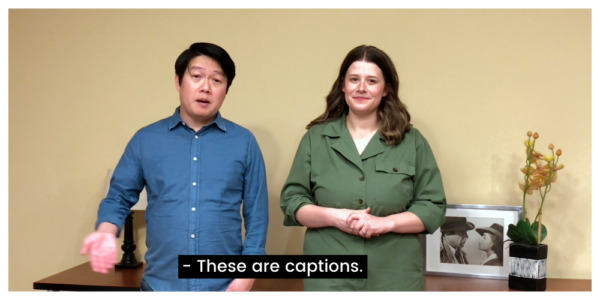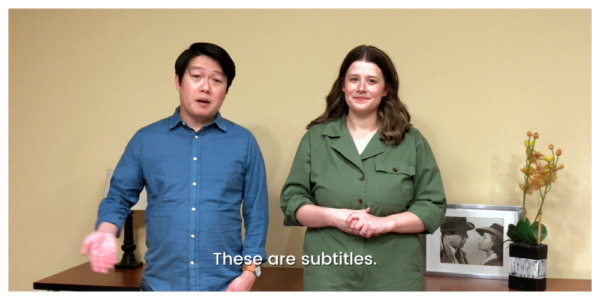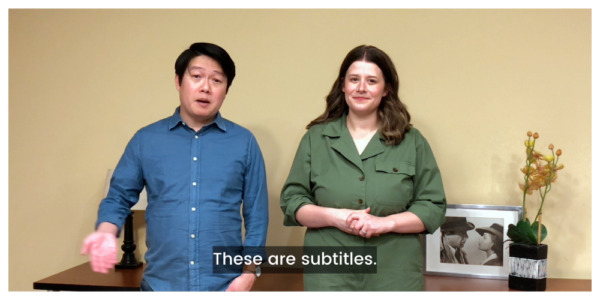Captions vs. Subtitles: Breaking Down the Differences
Updated: December 13, 2023
Video Accessibility 101 [FREE Course]
Captions and subtitles are important timed text solutions that make video content accessible to all audiences. But over the last several years, the two have become clouded with questions and confusion, with the top concern being “What’s the difference between captions vs. subtitles?”
Many experts have weighed in, slapping labels to “captions” and “subtitles” in order to give each a singular, yet narrow definition. Now, some of these definitions may be correct, but they’re often only partially so. Why?
Captions and subtitles are a lot more complex than most people realize. While they may seem interchangeable, understanding the differences between captions and subtitles is an important step in determining the most appropriate option for your video content.
In this blog, we’re diving head-first into the captions vs. subtitles debate. We’ll define timed text, captions, and subtitles; review the various types of captions and subtitles; and explore why they’ve become such a source of confusion in recent years.
What is a timed text?
A timed text is a text-based file that includes timing information.
In the accessibility space, timed text files are usually intended to pair the transcription of dialogue and/or sound to media. The timing information allows the text to be synchronized to specific time codes of media. Both captions and subtitles are forms of timed text.
What are captions?
Captions were introduced to accommodate D/deaf and hard of hearing television viewers in the early 1970s. Eventually, captions became a mandated requirement for broadcast television in the United States.
Captions provide a textual transcript of a video’s dialogue, sound effects, and music. Captions are designed for use by D/deaf and hard of hearing audiences, but have gained popularity with all audiences.

Standard closed captioning style: white text on a black box.
Captions appear as white text over a black box by default, but can sometimes be customized by viewers, depending on where media is being viewed. Placement varies, but is often centered at the bottom of the screen for readability. When graphics or text appear in the lower third of the video, captions are typically placed at the top of the screen.
608 Captions
608 closed captions (also known as CEA-608, EIA-608, or Line 21 captions) were the standard captioning type for analog television transmission. 608 captions are unable to be customized by viewers, though they are compatible with digital television.
708 Captions
708 closed captions (also known as CEA-708/EIA-708/CTA-708 captions) are the newer standard captioning type for digital television. 708 captions are customizable by viewers, but are not compatible with analog television.
What are subtitles?
Subtitles were introduced in the 1930s, when silent film transitioned to “talkies,” or film with spoken audio, in order to accommodate foreign audiences who didn’t understand the language used in a film.
Subtitles provide a textual translation of a video’s dialogue. Traditionally, subtitles assume the viewer can hear the audio but cannot understand the language. The exception to this is subtitles for the D/deaf and hard of hearing, which assume the viewer cannot hear the audio or understand the language.

Common subtitle style: white text with black dropshadow, no background.

Subtitles mimicking the appearance of closed captions.
Subtitles can appear in a variety of styles, but often appear as white or yellow text outlined in black, or with a black dropshadow. It is also common for subtitles to mimic the appearance of captions. Placement varies, but is often centered at the bottom of the screen for readability and ease in translation. When graphics or text appear in the lower third of the video, subtitles are typically placed just above the graphic/text. Subtitles can sometimes be customized by viewers, depending on where media is being viewed.
Become a video accessibility expert 🤓
non-SDH
Non-subtitles for the d/Deaf and hard of hearing (non-SDH) are traditionally referred to as just “subtitles.” Non-SDH are designed for viewers who can hear the dialogue and non-dialogue information but cannot understand the language. The only transcribed element of non-SDH is dialogue. On-screen graphics or words may also be transcribed, when time allows for the translation of these elements.
SDH
Subtitles for the D/deaf and hard of hearing (SDH) assume the end user cannot hear the dialogue and include important non-dialogue information such as sound effects, music, and speaker identification.
SDH were originally designed for viewers who cannot understand the language, but are increasingly used in place of captions on some video platforms and services.
Forced Narrative
Forced narrative (FN) subtitles, also known as forced subtitles, clarify pertinent information meant to be understood by the viewer. FN subtitles are overlaid text used to clarify dialogue, burned-in texted graphics, and other information that is not otherwise explained or easily understood by the viewer.
Open: The captions or subtitles are permanently visible or burned onto the video. The viewer cannot turn them off.
Closed: Captions and subtitles are not visible unless they are turned on. The viewer can toggle the captions or subtitles on and off at their leisure.
Why are captions sometimes called subtitles and vice versa?
Captions and subtitles are infamous for being confused with one another, and there’s a few reasons for this. Let’s take a quick look at how global differences in terminology and the increased usage of SDH have been adding chaos to the CC vs. subs discourse.
Global Terminology Differences
Outside of the United States and Canada (for example: the UK, Ireland, and most other countries), video subtitling and captioning are usually considered one and the same. In other words, the use of the term “video subtitling” does not distinguish between subtitles used for foreign language translation, and captioning used to aid the D/deaf and hard-of-hearing audiences.
The globalization of video content across corporate, education, and entertainment industries has greatly impacted how viewers use the terms “captions” and “subtitles”. It can be hard for viewers to understand the difference between the two when different entities label their accessible timed text files based on regional preferences.
SDH = CC…for some
Because of the aforementioned globalization of video content, closed captions and subtitles for the D/deaf and hard of hearing are now commonly mistaken for one another. It’s easy to see why: they both serve D/deaf and hard of hearing audiences and often look alike.
But SDH and captions are different. SDH were initially designed to accommodate D/deaf and hard of hearing audiences who could not understand the language. But over the past few years, SDH have been used in place of captions on platforms where traditional captions are not supported. Sometimes the platform will refer to SDH as “SDH”; other times, they may be called “CC”. There are even cases where they could be called both, e.g. “CC/SDH”.
Captions vs. Subtitles
Because of the many nuances involved in defining captions and subtitles, it’s hard to compare both in general terms. To get to the heart of the individual differences between them, it’s important to break captions and subtitles down into their individual types.
Feature
Captions
Subtitles
608
708
SDH
non-SDH
FN
Text transcribed
All
All
All
Dialogue only
Only pertinent dialogue & information not easily understood by viewer
Timed text synced to video
√
√
√
√
√
Audience assumption
D/deaf and hard of hearing
D/deaf and hard of hearing
D/deaf and hard of hearing
Hearing
Hearing
Can be turned on/off
√
√
√
√
√
In source language
√
√
√
Sometimes
Sometimes
Speaker identification
√
√
√
Music & sound effects
√
√
√
Signs & graphics transcribed
Sometimes
√
Translation options
Limited
Limited
√
√
√
Appearance
White text on black box; 32 characters per line
White text on black box; 32 characters per line
Varies; 42 characters per line
Varies; 42 characters per line
Varies; 42 characters per line
Placement
Varies–usually centered at bottom, moving to top for lower third graphics
Varies–usually centered at bottom, moving to top for lower third graphics
Varies–usually centered at bottom, moving to top or just above lower third graphics
Varies, usually centered at bottom, moving to just above lower third graphics
Varies, usually centered at bottom, moving to just above lower third graphics
User Customization (when available)
√
√
√
√
There’s a lot of nuance missing from the captions vs. subtitles discourse, and the complexities of each won’t go away anytime soon. In the broadest sense, each serves a different purpose with a common goal:
- Captions provide an accessible way for viewers who cannot hear audio to watch video.
- Subtitles provide an accessible way for speakers of any language to watch video.
Video accessibility is the string that ties captions and subtitles together, but there are ways to move beyond generalization of these accessibility solutions. The question of “what’s the difference between captions vs. subtitles?” is one that will always require us to break it down further. By comparing and contrasting the individual types of captions and subtitles, we can begin to grasp the differences between the two a lot more easily.
This blog post was originally published by Sofia Leiva on August 14, 2016, and was updated on June 22, 2021 by Kelly Mahoney. It has since been updated again for comprehensiveness, clarity, and accuracy.
Further Reading

Subscribe to the Blog Digest
Sign up to receive our blog digest and other information on this topic. You can unsubscribe anytime.
By subscribing you agree to our privacy policy.










